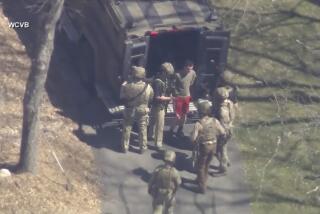NATO Asked to Back U.S. on Treaties : Weinberger Appeal Meets Resistance From Some Allies
BRUSSELS — Defense Secretary Caspar W. Weinberger asked his NATO counterparts today to formally back U.S. charges that the Soviet Union is violating arms control agreements.
But he encountered resistance from some European defense ministers, according to sources who spoke on condition of anonymity.
In seeking to convince the United States’ allies that the Soviets are violating arms control treaties, Weinberger presented photographs, charts and other intelligence data, officials said.
Manfred Woerner, the West German defense minister, said Weinberger showed spy photographs of Soviet SS-25 missiles in three locations in the Soviet Union. He did not say whether Weinberger disclosed the number of missiles deployed.
Violation Claimed
Weinberger announced last week that the Soviets had deployed the SS-25, an intercontinental nuclear missile, in violation of the unratified SALT II arms accord. The Soviets say the missile is allowed by SALT II because it is a modification of an existing system, the SS-13.
Weinberger also produced spy data to support his claim that a new radar system being built in Siberia was in breach of the anti-ballistic missile treaty, Belgian Defense Minister Freddy Vreven said.
While the European ministers did not dispute the accuracy of the evidence presented by Weinberger and his aides, they were hesitant to publicly state that the Soviet actions were treaty violations, according to British and other sources.
The Europeans are not parties to either the SALT II or ABM treaties.
Presented Spy Photos
A British government source, speaking on condition of anonymity, said Weinberger also presented U.S. intelligence photographs of the Soviet Union’s SS-20 medium-range nuclear missiles, which are not limited by treaties. Weinberger reiterated that 441 of the SS-20s are operational throughout the Soviet Union, Vreven said.
In the opening session of a two-day meeting, the defense ministers also were given a U.S. briefing on advances in Soviet research on a “Star Wars” missile defense system, according to sources who spoke on condition they were not identified further.
More to Read
Sign up for Essential California
The most important California stories and recommendations in your inbox every morning.
You may occasionally receive promotional content from the Los Angeles Times.










